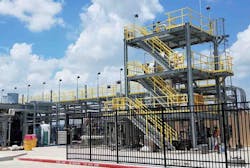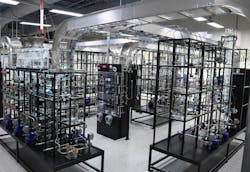San Jacinto College trains staffers for Houston Ship Channel companies
Key highlights:
- The Houston Ship Canal’s concentration of petrochemical facilities, supported by San Jacinto College’s CPET program, helps ensure a steady supply of skilled operators and controls professionals.
- CPET’s large-scale labs, simulators and live process units (all equipped with industry-standard hardware and software like Emerson DeltaV, Siemens analyzers and Rosemount transmitters) provide controls engineers with real-world, hands-on experience before entering the field.
While some locations and regions in the process industries have suffered workforce shortages and skills gaps, the Houston Ship Channel reportedly isn’t one of them. This is understandable because it has 130 petrochemical plants within a 12-mile-radius that employ 30,000 people directly, support more than 120,000 jobs indirectly, and export about 40% of the products they produce, according to James Griffin, senior VP for petrochemical and energy technology at LyondellBasell’s Center for Petrochemical Energy & Technology (CPET) at San Jacinto College in Pasadena, Texas.
“This summer‘s enrollment is up 32% to more than 1,300, including students earning two-year degrees, and current operators, technicians and other process-industry professionals getting retrained and gaining new skills,” says Griffin.
Supported by more than 40 corporate partners, CPET has been teaching operators and process technologists for 30 years. It’s 151,000 square feet of labs and other facilities include:
- Analyzer lab with four Siemens gas chromatography (GC) units and two Applied Automation GC units, Siemens continuous emissions monitoring system (CEMS), 12 pH analyzers from Rosemont and Yokogawa, Siemens O2 combustion analyzer, and three tabletop Siemens GCs.
- Digital control system (DCS) lab with five process control stations and 10 student computing stations running Emerson‘s DeltaV DCS software.
- Process equipment lab with four acrylic exchanger models, gate, ball, check and control valve cutaways, five pump cutaways, and miscellaneous other devices and parts for students to handle.
- Electrical labs with Eaton equipment, including 12 Future Tek motor control training packages, 12 motor control centers (MCC), 5 kV metal-clad switchgear, Magnum DS low-voltage switchgear, and Pwr-R-Line switchboards.
- Glycol unit with recycling propylene glycol distillation unit has a 32-ft, eight-tray column, DeltaV DCS, cooling water, boiler and reverse osmosis utilities, and 72 I/O with smart Rosemount transmitters (Figure 1).
Get your subscription to Control's tri-weekly newsletter.
“These are good industries run by global companies that treat their employees well and create growth opportunities, which enables them to do a great job of recruiting and maintaining quality workforces,” says Griffin. “These opportunities allow our students to be successful, earn starting salaries just over $70,000 on average, and return to support the college and our frequent career days and other events. The typical degree takes about two years to complete, but many of our students are already hired by employers before they graduate.”
Beyond supporting its labs and programs with equipment, CPET’s partners also collaborate with it on curriculum development, best teaching practices, and balancing on-campus instruction with on-the-job training. “One partner had an eight-week training program, but they wanted to cut it to four weeks in-house, so we looked at handling some of them,” adds Griffin. “We were also able to cover some of this material more thoroughly, which allowed the students to retain more of it.”
Likewise, Griffin reports that CPET embeds critical-learning content and skills into its courses, which students can use in multiple areas of their subsequent jobs. These include instruction in process safety issues, taking water and air samples to meet environmental standards, and learning applied chemistry and physics.
This is part three of Control's August 2025 workforce cover story. Read the other installments here.
About the Author

Leaders relevant to this article:


